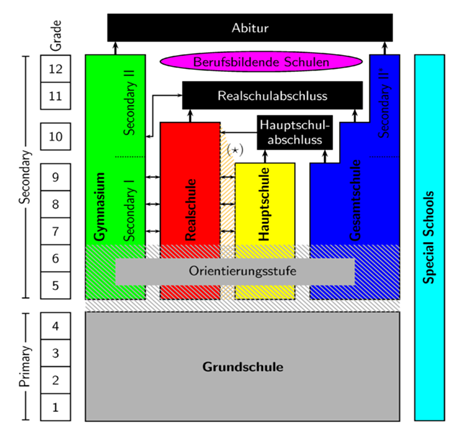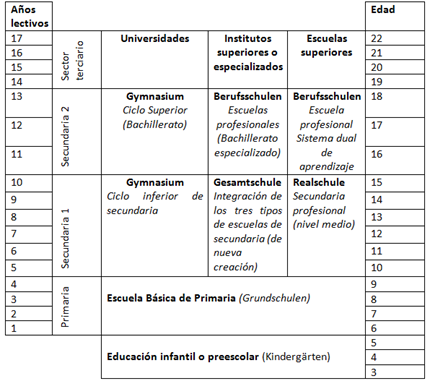It is difficult to speak of a single education system in Germany, since education is the responsibility of the different counties (Länder). The federal government sets general goals and actions and the Länder implement them. Both state and federal institutions must pursue common objectives. To this end, ministries of education from all 16 Länder meet regularly to discuss issues of shared interest, while a Governmental commission coordinates education policies among the Länder. For this reason, some aspects are very similar throughout the country.
In Germany, schooling is optional for children aged three to six, but compulsory thereafter . Education is compulsory from the age of six and for at least nine years (ten years in some Länder). It is usually free from primary school to university, although some attempts are being made to introduce and increase fees at universities.
Unlike other countries, Germany has always had an egalitarian education system. There are special schools for those with physical and mental disabilities, but there are no elite schools like in France or the UK.
However, from the age of ten onwards, the German education system separates children into three different types of schools (Gymnasium, Realschule and Hauptschule) according to the level they have demonstrated during their first four years of school. Due to the different types of schools and the importance attached to results, the German school system is very rigid and often criticised for determining the future of a child at a very early age, so that some Länder have set up other sorts of schools known as Gesamtschulen that integrate the three types of schools and where children are taught up to the age of 16.
In order to enter college, high school students must take an exam (Abitur) which can be taken at the Gymnasium and at the Gesamtschule. At the end of year 10 (10. Klasse) at a Realschule, and the year 9 (9. Klasse) at a Hauptschule, students receive a dual vocational training which allows them to learn a in a company.
Some critics complain that the German education system focuses only on academic learning, without taking into account the holistic part of education as in British and American schools. Most German schools have no extracurricular activities, such as sports clubs or musical activities, so that those activities are offered outside the school by other companies.
Primary Education (Grundschule)
Primary education begins between five and a half to six and a half years of age, depending on the month in which the child is born.
Primary education lasts for four years, after which parents will receive a recommendation from teachers as to what type of school is best suited for the child to continue his or her education in secondary school. This recommendation is based on the teacher’s assessment of the child’s results, level adquired and interests. If a child has learning difficulties, the teacher may recommend sending him/her to a school for Special Education Needs (Sonderschule).
Lower Secundary Education (Sekundarstufe I)
After primary school, when children are 10 years old they usually go to one of the three types of secondary schools, depending on their academic level. The lower secondary level (Sekundarstufe I) covers up to 15/16 years of age at the end of the stage for compulsory education.
– Hauptschule (until students turn 15/16 years old) prepares students for vocational training and finishes with a test known as Hauptschulabschluss. The Hauptschule is designed for students who are less bright academically. Once they graduate, after Klasse, students usually receive a dual vocational training that allows them to learn a trade in a company through an apprenticeship (Lehre) in some manual occupation, which they sometimes combine with part-time studies at a vocational school (Berufsschule).
– Realschule (until students turn 15/16 years old) offers more options for middle level students and ends with the Realschulabschuss The Realschule is designed for those students who are going to do professional training internships, once graduated after finishing the 10. Klasse, and who need more academic learning, such as nursing, and more emphasis is placed on math and language skills than on manual learning.
– Gymnasium (until students turn 15/16 years old). The Gymnasium is the type of school that prepares students for higher education. Students who wish to go to college stay in these centers to continue their upper secondary education.
In some regions of Germany, there are other types of schools called Gesamtschulen. All children go to the same school, but they are separated according to their academic knowlegde. At the age of 16, depending on the results they have achieved so far, students can finish school to do a Lehre. If they want to go to college they stay in these schools to continue with upper secondary education.
Upper Secundary Education (Sekundarstufe II or Gymnasiale Oberstufe)
After completing compulsory secondary education, students, who are about 15 years old, can choose between the Gymnasium or Gesamtschule, in both of which they stay for 3 years, starting from 10. Klasse to 12. Klasse or, in some Länder, from 11. Klasse to 13. Klasse.
– Gymnasium of upper secondary education (up to the age of 18 or 19) ends with the Abitur exam (a requirement to enter university). This is the most demanding type of school, with 32 to 40 hours of classes per week and lots of homework.
– Gesamtschule of upper secondary education (up to the age of 18 or 19) ends with the Abitur exam.
 |
 |

